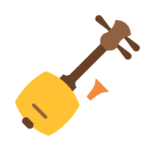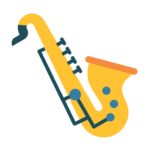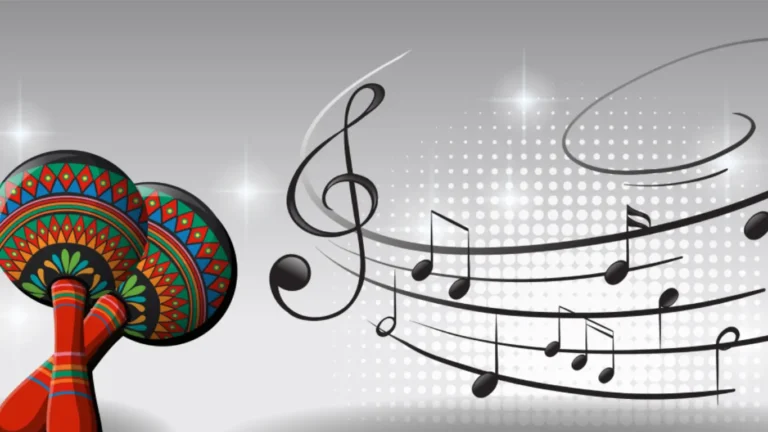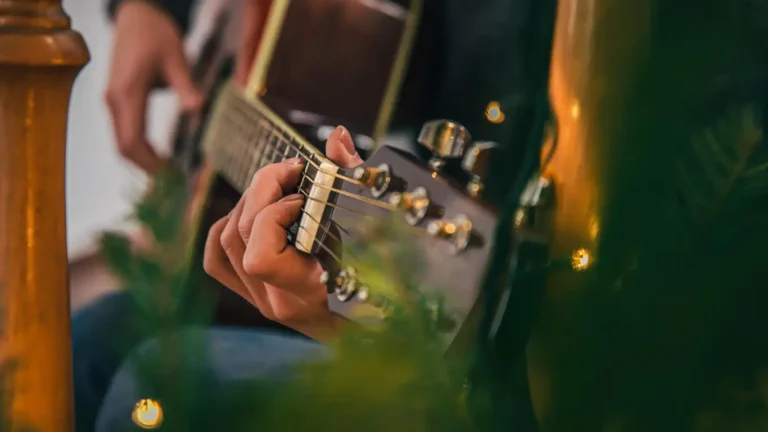For centuries, people in the Middle East and Central Asia have played the Daf, a simple but powerful frame drum. It's more than just a musical Persian instrument; it signifies culture, tradition, and joy. From lively ceremonies to small family get-togethers, the Daf's steady beat creates a web of sound that brings people together across generations and elicits feelings beyond words.
This article delves into playing daf, discussing its long history, various musical styles, and powerful effects on the player and the audience.
What is a Daf Instrument?
The Daf instrument is a large-frame drum traditionally used in the Middle East, including Armenia, Iran, Turkey, Azerbaijan, and Greece. It is sometimes spelled as Daf, Daff, Deff, or Duff. The frame of the Daf is made of wood, with metal rings attached around the inside.
Typically, the membrane of the Daf is crafted from animal skin—such as goat, horse, or cow hide—though modern versions sometimes use synthetic materials. The sturdy wooden frame typically measures 48-55 cm in diameter, with the membrane tightly stretched over it. Metal pegs are placed behind the frame to keep the skin taut.
Unlike some other drums, the Daf doesn't have jingles attached directly to the membrane. Instead, hooks inside the frame hold the metal rings, which produce a jingling sound as the drum moves, adding a distinctive layer of sound to the rhythm.
Read More: Iranian Drums: Daf, Tombak & Azeri Dayereh
How to Playing Daf?
To play the Daf drum, the Daf player strikes the membrane with their hands, using finger strokes to create different tones. The instrument allows for expressive rhythm, from soft, soothing patterns to energetic beats. The jingles (metal rings) inside the frame add a shimmering quality to the sound, enriching the rhythm and making it ideal for group performances or spiritual rituals.
How difficult is it to learn to play the Daf?
If you're a beginner and wondering how difficult it is to play the Daf, here's what you can expect:
Learning the Daf can be challenging at first, but it's definitely manageable with practice. As a beginner, you’ll start with basic rhythms and simple hand techniques. It might feel a bit tricky at the beginning, especially when it comes to coordination between both hands. The Daf is unique in how you play it, with your fingers and palms creating different sounds.
- Initial Difficulty: The biggest challenge will likely be developing a sense of rhythm and getting used to the feel of the drum.
- Learning Pace: Everyone progresses at their own pace, so with regular practice, you'll pick it up faster than you might think.
- Long-Term: As you advance, you’ll start working on more complex rhythms and faster beats, which will require more practice, but it’s all part of the journey.
In short, while it’s not "easy," it’s definitely doable with patience and consistent practice. The more you play, the easier it will get!
Read More: 6 Magical Instruments Like Handpan
An In-Depth Learning Path for Beginners
Starting your journey with the Daf instrument might seem daunting at first, but rest assured, with consistent practice and the right guidance, you'll find your rhythm and confidence in no time. Learning to play the Daf is an exciting process, one that rewards patience and dedication. Here's an in-depth guide to help you navigate the early stages of becoming a proficient Daf player:
1. Understanding the Daf
Before you even pick up your Daf drum, it's crucial to familiarize yourself with its structure and sound. Start by learning the parts of the instrument—the frame, membrane, and jingling rings (Zanjir)—so you understand the elements that contribute to its unique sound.
2. Basic Rhythms and Hand Techniques
As a beginner, you'll begin with simple hand techniques. Use your fingers, palms, and even the heel of your hand to explore the different sounds the Daf musical instrument can create. Start with basic rhythmic patterns, like "Dum" and "Tak", and practice slowly, focusing on coordination between both hands. You might find this challenging at first, but keep practicing!
Tip:
Start by tapping softly on the Daf to hear the subtle difference between tones made by various parts of your hand. Practice these basic rhythms daily until they become second nature.
3. Building Up to Complex Rhythms
Once you're comfortable with the basics, it's time to challenge yourself with more complex rhythms and faster beats. Experiment with varying your hand pressure and speed, transitioning from slow to fast rhythms. These small adjustments will give you more control over the sound, allowing you to express a wide range of emotions and energy through the Daf drum.
Tip:
Try layering different rhythms or syncing your beats with other instruments. The Daf is often played in ensembles, so practicing in a group setting can also help you gain musical insight.
4. Consistency is Key
As with any instrument, regular practice is essential to improving your Daf skills. Don’t rush to master advanced techniques—progress at your own pace. Set achievable goals each week, whether it’s perfecting a new rhythm or strengthening your hand coordination.
Read More: Hang Drum Tuning vs Handpan
The Daf in Popular Music
While the Daf is deeply rooted in Persian and Middle Eastern traditions, its versatility has made it a sought-after instrument in a range of contemporary genres. Today, Daf music can be heard in world music, fusion, and even experimental genres. Musicians from all around the world are integrating the Daf drum into their compositions, blending its traditional sounds with modern styles.
Incorporating the Daf into Modern Music
The shimmering jingles and resonant tones of the Persian Daf instrument add a unique texture to modern tracks. You might hear the Daf in contemporary fusion ensembles, where it is played alongside electric guitars, keyboards, and percussion. Its dynamic rhythms work beautifully in the creation of ambient music, providing an organic, earthy layer that complements electronic elements.
Some artists have taken inspiration from the Daf and incorporated it into experimental genres, where its intricate rhythms create a rhythmic foundation in fusion compositions. Whether in a live world music concert or through recordings, the Daf continues to evolve, offering an exciting new perspective on modern rhythms.
If you're a fan of global fusion or world music, keep an ear out for the Daf! It’s likely that a talented Daf player will be contributing to the rich soundscape you're enjoying.
Read More: The Power of Music in Healing and Relaxation
Maintenance and Care of Your Daf
To ensure your Daf musical instrument remains in excellent condition for years to come, it’s important to care for and maintain it properly. Here are some essential maintenance tips to keep your Daf drum sounding its best:
1. Storing Your Daf
When not in use, always store your Daf in a dry place, away from direct sunlight and extreme temperatures. Exposure to heat or humidity can cause the skin membrane to warp, which may negatively affect the sound quality. A padded bag or case can also protect the Daf from physical damage when traveling.
2. Tightening the Skin
Over time, the membrane of your Daf may loosen or become uneven. It’s important to regularly check the tension of the skin. If it feels too slack, carefully re-tighten it using the metal pegs behind the frame. Make sure the skin is evenly stretched, as this will ensure a consistent tone.
Tip:
If you’re unsure about tightening the skin, consider seeking professional help or guidance from an experienced Daf player to avoid damage.
3. Cleaning Your Daf
To keep the Daf looking great, gently wipe the frame and skin with a soft cloth after each practice session. Avoid using harsh chemicals that might damage the material. Occasionally, you can use a slightly damp cloth to remove dirt or sweat, but be sure to dry the Daf thoroughly afterward.
4. Caring for the Zanjir (Jingles)
The jingles inside the Daf frame are integral to its sound, so make sure they are secure and not obstructed by dirt. You can clean them with a small brush or cloth, but avoid excessive force as it might damage the delicate rings.
Cultural Music Genres Featuring the Daf
The Daf is a key part of several cultural music genres, particularly in Persian and Middle Eastern traditions. Whether in folk, classical, or religious music, the Daf drum holds a revered place.
1. Sufi and Spiritual Music
One of the most iconic uses of the Daf is in Sufi rituals. In these spiritual practices, the Daf instrument is played to facilitate meditation and trance states. Its resonant sound is believed to connect the player and listener to a higher realm, often accompanying spiritual chanting and whirling dervishes in sacred ceremonies.
2. Persian Classical Music
In Persian classical music, the Daf provides a rhythmic foundation for traditional ensembles, playing alongside instruments like the tar, setar, and kamancheh. The rhythms of the Daf drum often serve as a metronome, ensuring the flow of music while simultaneously contributing to its emotional depth.
3. Folk and Traditional Music
The Daf has a strong presence in Persian folk music, often used in both celebratory and somber contexts. Its energetic beats can drive the rhythm of festive dances or create a meditative atmosphere in slower, more introspective pieces.
4. Fusion and World Music
In modern world music and fusion genres, the Daf is embraced for its unique sound and adaptability. Musicians blend the Daf's deep, earthy tones with other instruments from diverse cultures, creating a rich sound palette that spans from classical fusion to experimental jazz.
The Daf’s versatility makes it suitable for a wide array of musical genres, so whether you're drawn to traditional Persian melodies or looking to experiment with contemporary styles, the Daf can enrich your musical expression.
Summary:
By combining the Daf’s rich cultural heritage with a practical approach to learning, maintenance, and care, you’ll find that playing this beautiful musical instrument is not only a rewarding challenge but also a deeply fulfilling journey. Whether you're exploring its role in traditional Persian music or incorporating it into modern fusion, the Daf offers endless possibilities for creative expression. Stay committed to your practice and let the rhythms of this ancient instrument carry you to new musical heights!
Getting Started with Daf Lessons at Navasaz Academy
If you're looking to explore how to play Daf and dive into the world of Daf music, Navasaz Academy in Toronto is the ideal place to start your journey. As a center dedicated to Persian and Middle Eastern music, Navasaz offers the perfect environment for learning the Daf instrument with expert guidance.
Why Choose Navasaz Academy for Daf Lessons?
- Expert Instruction: Navasaz Academy is home to renowned teachers like Ali Massoudi, a master Daf player. With years of experience in playing Daf and Persian Daf instruments, Ali brings both technical expertise and cultural depth to every lesson. His personalized approach helps students of all levels—whether you’re a complete beginner or an experienced musician—develop the skills to become a confident Daf player.
- Comprehensive Curriculum: At Navasaz, you’ll learn more than just how to play Daf. Our Daf lessons cover everything from the basics of the Daf drum, including its structure and sound, to advanced rhythms and playing techniques. You'll also get a deep dive into the cultural significance of Daf music, making your learning experience richer and more meaningful.
- Cultural Immersion: Understanding the cultural context of Daf music is crucial for any serious Daf player. At Navasaz, you not only learn to play, but you also get to explore the spiritual and celebratory role the Daf instrument plays in Persian traditions, especially in Sufi rituals and festivals.
- Friendly, Supportive Environment: Learning the Daf instrument requires patience and practice, but Navasaz’s supportive community and experienced instructors make it easier. Whether you’re attending in-person lessons in Toronto or participating in online sessions, the academy ensures you receive the attention and resources you need to progress at your own pace.
Navasaz Academy is the best place to begin your journey into the world of Daf music. Whether you're learning the basics or refining your skills as a Daf player, the expertise and personalized approach offered at Navasaz will ensure you get the most out of your Daf lessons. Join us at Navasaz Academy and embrace the rhythms and traditions of the Daf instrument like never before!
Frequently Asked Questions
Persian Daf instruments are distinct due to their larger size, unique playing techniques, and cultural significance. Unlike other frame drums, the Persian Daf has jingles (Zanjir) attached inside the frame, producing a shimmering sound as the drum moves. The Persian Daf is traditionally made from goat, horse, or cow skin, giving it a rich, resonant tone. Additionally, the way it's played with the fingers and palms creates a dynamic range of rhythms, from delicate to energetic.
The time it takes to become proficient in playing the Daf depends on your dedication and practice. With regular Daf lessons, beginners can expect to start playing simple rhythms within a few months. However, mastering advanced techniques, like complex rhythms or performing in a group setting, might take years of practice. Patience and consistent practice are key!
Yes, absolutely! Daf lessons are designed for all skill levels, including beginners with no prior musical experience. While having some basic understanding of rhythm can be helpful, most beginners can learn the fundamental techniques through consistent practice. At Navasaz Academy, expert instructors like Ali Massoudi can help guide you through the basics and develop your skills at your own pace.
Yes, Navasaz Academy offers online Daf lessons for students around the world. Whether you’re looking to learn the basics of the Daf instrument or refine your playing skills, online lessons provide a flexible and accessible way to learn from expert instructors. The Daf lessons are personalized to fit your learning pace and are available via live video sessions, making it easy to get the same high-quality instruction no matter where you are.
Learning the Persian Daf instrument offers a unique cultural and spiritual experience that many other percussion instruments can’t match. The Daf is deeply rooted in Persian tradition and is often used in Sufi rituals for meditation and spiritual chanting. Through Daf lessons, you not only learn a musical instrument but also connect with centuries of history and culture. Additionally, the Daf's versatility makes it suitable for various musical styles, from traditional Persian music to modern compositions.
When purchasing a Persian Daf instrument, look for quality craftsmanship, durability, and the materials used. A good Persian Daf will have a solid wooden frame, high-quality animal skin (like goat or horse hide), and properly affixed jingles inside the frame. Pay attention to the overall resonance of the instrument, ensuring that it produces a clear, rich tone. It's also important to consider the size and weight based on your playing style and comfort.
Yes! While the Daf instrument is deeply rooted in traditional Persian music, its unique sound has found a place in contemporary music as well. Many modern musicians incorporate the Daf into genres like fusion, world music, and even experimental electronic music. The versatility of the Daf drum makes it suitable for different styles, adding a distinct rhythm and texture to any composition.
 String Instr
String Instr Percussion Instr
Percussion Instr Wind Instr
Wind Instr Keyboard Instr
Keyboard Instr Tools
Tools Books
Books

